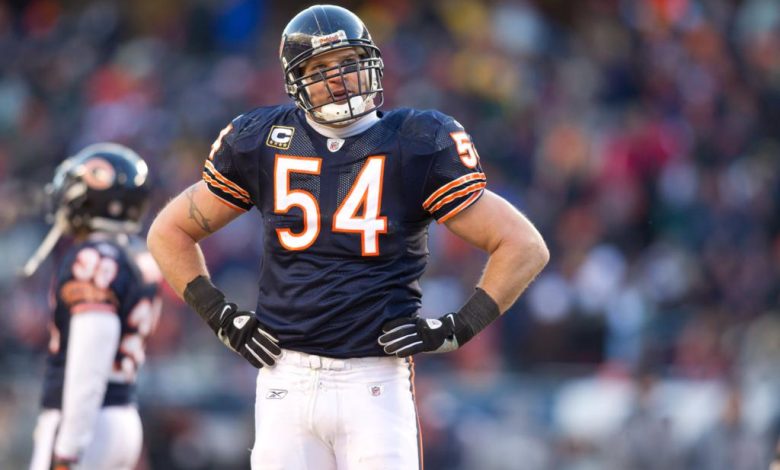Chicago Bears legend Brian Urlacher criticized transgender men in women’s sports, stating, “A woman is a woman, and a man is a man. You’re born with what you’re born with.”

In recent years, the participation of transgender individuals in sports has become a highly contentious issue, sparking passionate debates across communities, governments, and the sports industry. Prominent voices, including athletes and public figures, have voiced their opinions, often reflecting deeply held beliefs about gender, fairness, and identity. One such voice is Chicago Bears legend Brian Urlacher, who publicly criticized transgender men competing in women’s sports, asserting, “A woman is a woman, and a man is a man. You’re born with what you’re born with.”
This statement encapsulates a perspective rooted in traditional views of gender roles and biological differences. To understand the implications of Urlacher’s stance, it is essential to explore the broader context—examining the scientific, ethical, social, and legal aspects of transgender participation in sports, as well as the cultural debates surrounding gender identity.
Background: The Rise of the Transgender Sports Debate
The inclusion of transgender athletes in competitions traditionally divided by gender has gained prominence amid increasing awareness and acceptance of gender diversity. Historically, sports have categorized competitors based on biological sex, often to ensure fairness given physiological differences—such as muscle mass, bone density, and cardiovascular capacity—that can influence athletic performance.
However, with evolving understanding of gender identity, some transgender individuals, particularly transgender women (those assigned male at birth but identifying as female), seek to compete in women’s sports. This has sparked debates about fairness, safety, and inclusivity.
Key Issues in the Debate:
Fairness: Critics argue that transgender women may retain physiological advantages from male puberty, such as greater muscle mass, strength, and endurance, which could provide an unfair edge over cisgender women.
Inclusivity and Rights: Advocates for transgender athletes emphasize the importance of inclusion, human rights, and the recognition of gender identity as integral to personal dignity.
Safety: Concerns about safety arise in contact sports, where physiological differences could increase the risk of injury.
Legislative and Policy Responses:
Different jurisdictions and sports organizations have adopted varied policies. For example:
The NCAA has implemented guidelines allowing transgender women to compete in women’s sports if they meet certain hormone levels.
Some states in the U.S. have proposed or enacted legislation restricting transgender athletes’ participation in girls’ and women’s sports.
International bodies like the International Olympic Committee (IOC) have issued guidelines attempting to balance fairness and inclusion.
Brian Urlacher’s Perspective: “A woman is a woman, and a man is a man. You’re born with what you’re born with.”
Brian Urlacher, an iconic linebacker and Hall of Famer, has expressed a viewpoint aligned with traditional gender distinctions. His statement reflects a belief that biological sex, determined at birth, should be the defining criterion in sports participation. Specifically, he emphasizes that gender is rooted in biological reality, and that the natural differences should be preserved in athletic competition.
Interpreting Urlacher’s Statement:
Biological Determinism: The phrase underscores a perspective that biological sex—chromosomes, hormones, physical attributes—is the ultimate determinant of athletic ability and fairness.
Concerns About Fairness: Implicit in his comments is a concern that allowing transgender women to compete in women’s sports might undermine fairness, given physiological differences.
Traditional Views: The statement aligns with a more conservative or traditional view of gender, emphasizing fixed biological categories rather than fluid or socially constructed identities.
Scientific Perspectives on Gender and Athletic Performance
A critical part of the debate revolves around the science of sex differences. Researchers have documented consistent physiological disparities between average males and females, including:
Muscle Mass: Men generally have higher muscle mass and strength due to testosterone-driven development.
Bone Density: Males tend to have denser bones, providing structural advantages.
Cardiovascular Capacity: Men often have higher hemoglobin levels and greater lung capacity, contributing to endurance.
Hormone Therapy and Athletic Performance:
Some argue that hormone treatment can mitigate physiological differences. Transgender women often undergo hormone therapy to lower testosterone levels and develop female secondary sexual characteristics. However, questions remain about whether these treatments fully eliminate advantages derived from male puberty.
Studies show that transgender women may retain certain physical advantages even after hormone therapy, such as bone structure and muscle memory. The extent to which hormone suppression equalizes performance is still under scientific investigation.
Implications for Fair Competition:
Given these physiological realities, many argue that allowing transgender women to compete in women’s sports could create unfair advantages, especially in strength and power-based sports. Conversely, others contend that inclusivity and human rights should take precedence, emphasizing individual rights over broad physiological generalizations.
Ethical and Social Considerations
The discussion extends beyond biology and science into ethics, human rights, and social justice.
Arguments Supporting Inclusion:
Recognizing gender identity affirms individual dignity and human rights.
Excluding transgender athletes can reinforce discrimination and stigma.
Many sports organizations aim to balance fairness with inclusivity.
Arguments Supporting Restrictions or Caution:
Maintaining fairness in competition, especially in women’s sports, is crucial.
Protecting the integrity of women’s sports from potential physiological advantages.
Ensuring safety in contact sports.
Societal Impact:
Public figures like Urlacher shape the discourse, influencing public opinion and policy. Their statements often reflect broader societal debates about gender roles, identity, and fairness.
The Role of Public Figures and Media
When celebrities and sports icons speak publicly, their words resonate widely. Urlacher’s statement, emphasizing biological sex as the defining factor, aligns with a growing segment of public discourse that prioritizes traditional gender distinctions.
However, critics argue that such perspectives may oversimplify complex issues. They emphasize that gender identity is deeply personal and that policies should respect individual rights and scientific nuances.
Media and Political Responses:
Media coverage often amplifies these debates, sometimes polarizing opinions. Some advocate for more inclusive policies, citing human rights and equality, while others call for stricter definitions rooted in biology.
Legislators and sports governing bodies are often caught between these viewpoints, striving to craft policies that are fair, inclusive, and scientifically informed.
Ethical Dilemmas and Future Directions
The controversy over transgender participation in sports raises profound ethical questions:
How do we balance fairness with inclusion?
Should biological sex be the sole criterion, or should gender identity be equally prioritized?
What scientific evidence should inform policies?
How do we ensure that policies are equitable and respectful of all individuals?
The future likely involves nuanced approaches, including:
Sport-specific policies that consider the nature of the sport.
Implementation of hormone level guidelines.
Individual assessments rather than blanket bans or allowances.
Continued scientific research to better understand physiological impacts.
Navigating Complexity with Respect and Evidence
Brian Urlacher’s statement encapsulates a perspective rooted in traditional views of gender—one that emphasizes biological distinctions. While such viewpoints resonate with many, the broader societal and scientific conversations are complex and multifaceted.
As society continues to evolve in its understanding of gender and identity, so too must sports organizations and policymakers develop thoughtful, evidence-based approaches. Respecting individual rights while preserving fairness is a delicate balance requiring ongoing dialogue, scientific inquiry, and compassionate understanding.
Ultimately, the debate is a reflection of larger societal values—how we define fairness, identity, and human dignity. Public figures like Urlacher contribute to these conversations, highlighting the importance of honest discourse, even amid disagreement. Moving forward, fostering respectful dialogue and grounding policies in science and human rights will be essential in addressing these challenging issues.









